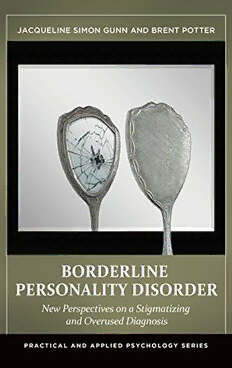
Borderline Personality Disorder: New Perspectives on a Stigmatizing and Overused Diagnosis PDF
Preview Borderline Personality Disorder: New Perspectives on a Stigmatizing and Overused Diagnosis
Borderline Personality Disorder Recent Titles in Practical and Applied Psychology Meta-PhysicianonCallforBetterHealth:MetaphysicsandMedicineforMind, BodyandSpirit StevenE.Hodes,M.D. The Powerful Bond between People and Pets: Our Boundless Connections to CompanionAnimals P.ElizabethAnderson SexualEnslavementofGirlsandWomenWorldwide AndreaParrotandNinaCummings The Global Muslim Community at a Crossroads: Understanding Religious Beliefs,Practices,andInfightingtoEndtheConflict AbdulBasit,Editor LivinginanEnvironmentallyTraumatizedWorld:HealingOurselvesandOur Planet DarlyneG.Nemeth,RobertB.Hamilton,andJudyKuriansky,Editors ThePsychologyofBlackBoysandAdolescents KirklandVaughansandWarrenSpielberg,Editors LucidDreaming:NewPerspectivesonConsciousnessinSleep RyanHurdandKellyBulkeley,Editors TheMythofBlackAnti-Intellectualism:ATruePsychologyofAfrican AmericanStudents KevinO.Cokley Borderline Personality Disorder New Perspectives on a Stigmatizing and Overused Diagnosis Jacqueline Simon Gunn and Brent Potter Practical and Applied Psychology Judy Kuriansky, Series Editor Copyright©2015byJacquelineSimonGunnandBrentPotter Allrightsreserved.Nopartofthispublicationmaybereproduced,storedinaretrieval system,ortransmitted,inanyformorbyanymeans,electronic,mechanical, photocopying,recording,orotherwise,exceptfortheinclusionofbriefquotationsina review,withoutpriorpermissioninwritingfromthepublisher. LibraryofCongressCataloging-in-PublicationData Gunn,JacquelineSimon. Borderlinepersonalitydisorder:newperspectivesonastigmatizingandoveruseddiagnosis/ JacquelineSimonGunnandBrentPotter. pagescm.— (Practicalandappliedpsychology) Includesbibliographicalreferencesandindex. ISBN978–1–4408–3229–1(cloth:alk.paper)—ISBN978–1–4408–3230–7(ebook) 1. Borderlinepersonalitydisorder—Diagnosis. I.Potter,Brent.II.Title. RC569.5.B67G87 2015 616.850852075—dc23 2014025566 ISBN:978–1–4408–3229–1 EISBN:978–1–4408–3230–7 19 18 17 16 15 1 2 3 4 5 ThisbookisalsoavailableontheWorldWideWebasaneBook. Visitwww.abc-clio.comfordetails. Praeger AnImprintofABC-CLIO,LLC ABC-CLIO,LLC 130CremonaDrive,P.O.Box1911 SantaBarbara,California93116-1911 Thisbookisprintedonacid-freepaper ManufacturedintheUnitedStatesofAmerica Contents SeriesForewordbyJudyKuriansky vii 1 Introduction:TheBorderlinePersonalityPersonified 1 TheScarletLabel 3 Mary 3 Andria 5 2 AHistoricalAnatomyofaSocialConstruction:“Wandering Womb,”Hysteria,PsychiatricDisease 9 Antiquity:MaladiesoftheFeminineandtheFeminineasMalady 10 MiddleAges:FromUterusasEndoparasitetoDemonicPossession 16 Modernity:FromBedevilmenttoBrainDisease:OrgasmTherapy andtheRiseoftheRespectedPhysician 20 DeliteralizingtheFeminine:Dynamic,Developmental,andSocial Contextualisms 24 ContextualismAbandonedandBPD’sFormalEntryintothe Psychiatric“Bible” 27 3 The“Borderline”asaHumanPerson:ContemporaryPerspectives 31 “Borderline”IstoPsychiatryasPsychiatryIstoMedicine 32 ContextsofAgony 34 AnExperientialistDescriptionofBeingwith“Borderline PersonalityDisorder” 41 4 ChewedUp—SpatOut:Jane’sStory 49 5 EmotionalJungleGym:Melanie’sStory 65 6 ThePermeableFrame:Ethan’sStory 81 7 WateringFlowers:TheStoriesofCaroline,Violet,andCharley 97 8 Conclusion:Reflections,NewDirections 109 vi Contents References 115 Appendix:WellnessandRecoveryResources 121 Index 157 Series Foreword FromthemomentIspoketoDr.BrentPotterabouthisthoughtsaboutwhatis commonly called “borderline personality disorder,” I knew he had to write a book. Iknewhehadanewviewofthis“condition”thathaslongbeenadiagnosisin theprofessionandbecominganincreasinglyusedwordinthepublic. LittledidIknowhowchallengedIwouldbethemoreIreadthemanuscript andtalkedtoBrentabouthisapproach. ForthecoauthorsBrentandhiscolleagueDr.JacquieSimon,“borderlineper- sonalitydisorder”isamisnomerthatsadlystigmatizesthepeoplewhosufferfrom thiscomplexoffeelingsanddisplayconfusingbehaviors.Theymakeaconvinc- ingargumentaboutnotusingthewordandaboutanewwaytoviewandhelp suchpeopleandpatients. Likesomanyothers,I’mcomfortablewithlabels.I’vespentyearsinthefield using psychiatric diagnoses easily in writing, communicating, and teaching. Whenbarelyoutofcollegeaftermajoringinpsychology,Iwassweptintothe worldofpsychiatricnomenclature,workingattheNewYorkStatePsychiatric Institutewithateamofesteemedpsychiatristsonmultimillion-dollarresearch grantscomparingBritishandAmericandiagnosesofschizophreniaanddepres- sion.We’dshowvideotapesofpatientsandaskpanelsoftheexpertsfromthedif- ferentcountriestolabelthepatientaccordingtotheprevailingclassificationof disorders.Theresultsshowedthatthesamepatientcouldbelabeleddifferently byexpertsondifferingsidesoftheocean.Myimmersionindiagnoseswasmade morekeenwhilestillan“earlycareerprofessional”inthe1970s,whenIwashon- oredtobeinvitedtojoinapanelofexpertsledbyDr.RobertSpitzer,reframing theclassificationsinthefamousDiagnosticandStatisticalManual,whichclassifies anddescribesthesymptomsandnamesforthe“mentaldisorders.”Atthattimeit wasDSM-III,whichhasnowmorphedintofurtherrevisionstobecomeDSM-5. Then, when I wrote my book The Complete Idiot’s Guide to Dating, I even includedachapterwarningaboutpersonalitydisordersthataredatingdisasters, like the Narcissist who cares more for him- or herself than you, and the viii Series Foreword Passive-Aggressivetypewhoseangershowsupinbackhandedcomplimentsthat arereallydigs. The labels have increasingly crept into common language. I notice people casuallysayingabout themselves, “I’mbipolar”orabout others, “He’sschizy.” A guy suddenly sends venomous texts after declaring undying affection three timesaday,andtheconclusionis:“He’sborderline.”Awomantricksherfriend intopayingforatrip,leadingtotheassessmentthat“she’sborderline.”While unstable stormy relationships, manipulation, labile moods, and irresponsible behaviorsaretypicalsymptoms,it’sbecomealltooeasytousethelabel. American singer-songwriter Madonna even popularized the word “border- line”inherhitsongwiththattitleword,aspartofher“VirginTour”intheearly 1980s. In the song, she is a prisoner who is “going to lose my mind,” who bemoanstoananonymousloverthat“Whenyouholdmeinyourarmsyoulove metillIjustcan’tsee...Butthenyouletmedown,”whichtoclinicalearsis typicalofthe“borderline”personwhodrawsyouinbutthenpushesyouaway. It’sachallengenottolabel,andthennottotreatsomeoneaccordingtothe disorder. Myfirstpowerfulexperienceaboutthischallengewaswithapatientwhose caseIwasassignedto,duringmyinternshipinapsychiatricwardofahospital. Shehadbeengiventhediagnosisofbeing“borderline”andhadbeeninthe hospitalfortwoweekswhenshetoldmethatshegotacalltocomeonajobas aproduction assistanton amovie. Shewasthrilledsincethatwasthejob she lovedandhadbeforeshewashospitalized.Atthecasereviewthatnextmorning, afamouspsychiatrist,OttoKernberg,wascalledtoconsult.Hisrulingwasthat sheshouldnotbereleasedbecauseshewasnotthroughwithtreatment,andgiv- ingin toherrequesttoleavewould onlyfeedhersymptomsofnarcissismand manipulation,andwouldriskhernotreturningtothehospital.Thoughgreen in comparison to the big guns with years of experience, I argued that why shouldn’t she geta pass to go do what would help herfeelgoodabout herself, andhelpherreadjustinsociety.Iarguedfromtheopposingpositionofanother famous psychiatrist, HeinzKohut, whosepoint ofview maintained thattreat- ment should center on encouraging apatient’snarcissistic desires, wishes and needs—to open up during the process of transference. It was a more humane approach. I wanted her to get that job and build self-esteem, to work on her “problems”fromastrongerplace.Alas,Iwasoverruledandhadtotellherthat she could not take the job. The next day, she attacked me in the hall. Proof, Iwastold,thatthedecisionwascorrect;shewasunpredictable,aggressive,and notpreparedtoleavethehospital.Tothisday,whathappenedhauntsme. Thisbookrevivesallmyreflectionsaboutthat“case.” IchampionedBrentandJacquieto writethisbookbecauseIknewitwasa braveefforttoconfrontthe prevailingtrendtostillusethelabel“borderline.” In reading the manuscriptat various stages, Iwaschallenged—and welcomed Series Foreword ix thestimulation—toopenmymind,towatchmywords,andtonotthinkabouta disorder,asyndrome,oradisease. BrentandJacquiehavepresentedanimportantbookwithaprovocativenew view.Ireadwithexceptionallykeeninterestabouttheirownjourneyasprofes- sionals intermixed with intelligent accounts ofclinical work with real people struggling with difficult feelings and behaviors. The challenge they present becamemostpoignantwhenIaskedthemtoincludeachapterabouthowpart- nerscancope”withsuchpatients.YetBrentilluminatedmethatincludingtyp- icaladviceabout“Howtolivewith...”isexactlyantitheticaltowhatheand Jacquiearetryingtocommunicate.Thealternativeisevidentineverypageof theirbook,inthecasesandinthereferences,whichmustbereadanddigested. It’saboutthepersonandtheircontext,notthelabel,theyconvincinglypur- port. You have to read the book to see how this unfolds, how much sense it makes,andhowyoutoocanbechallengedtorethinkyourviewandapproach astohowandwhypeopledowhattheydo. JudyKuriansky,SeriesEditor PracticalandAppliedPsychology
